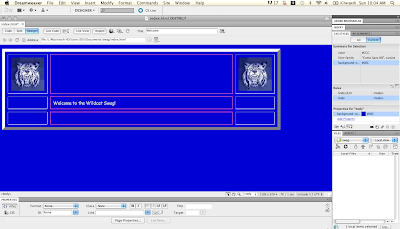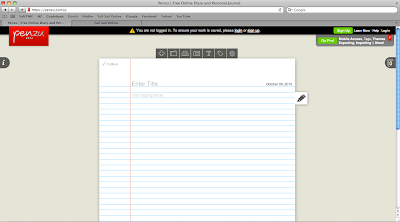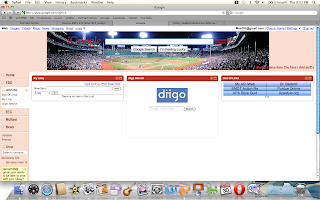This blog is for the Emergent Technologies in a Collaborative Culture class at Full Sail University.
Sunday, October 24, 2010
PE-Week 4-Pt 3

As I continue working on my school webpage I realized the table layout is just not working for me. I realized this after I created a new title for the page using Photoshop. I was a little disappointed because I could not find anything on Lynda about using text in Photoshop. As I analyzed the appearance of my original title, I thought that it was too plain, which is why I needed to redesign the title. I figured an image would add some life to it, but I am not a fan of the image I used. It is a picture of my school, but I do not think it adds the “life” I was in search of. I may try to get some pictures of the kids and try to piece them in spaces to the left and right of the word wildcat.
Initially, I thought the words word bland, but I created the words again, but in a different color and created a 3D effect by putting one behind the other. It is not perfect, but I think it looks much better than with what I started. I am starting to realize that even though I am using Dreamweaver to create the site I am in need of a decent amount of knowledge of the other Adobe products to make it look better.
Up next in my quest to create the perfect website…figuring out how to create placeholders for text and images, but that is for another blog post.
PE-Week 4-2

Spry Menu Widget for Dreamweaver
The second part of the website I learned about was the Spry Menu Widget, which enables the user to create a menu bar for the website. Fortunately, Lynda has a video that gave me the steps to follow to customize my Menu Bar. My prior experiences with Dreamweaver had me creating a menu using Flash, but now it is Spry. I am not sure what Spry is, but I must say it was fairly easy to create and change. Once have completed the other pages I will be able to connect all the pages to this menu.
My primary issue now is the color scheme…I had initially thought I could use the school colors for the website, but the more I see the colors in action the less I like the site. I wonder if Lynda has a video for understanding website color.
Some issues I am having now is my extreme dislike for the title section, which I created using Photoshop. I am thinking I should use an actual picture with the title included. I guess that is another personal experience to create.
PE-Week 4-1

All I can say is WOW!
I have been using Adobe Dreamweaver for a number of years to create websites, but have always used the template and “cheated” my way through. However, using the Lynda and the tutorials I have begun the process of actually learning how to use Dreamweaver. For this part of my personal experience, I have begun the process of understanding the purpose and functionality of Cascading Style Sheets or CSS. The ability to control fonts and layout of the webpage is very important when creating the initial page because it will act as a template for all the other pages.
The purpose of this website is to create a place for my 7th grade students to upload the content of The Wildcat Swag, our virtual student newspaper. My original layout was created using iWeb, which was good, but it did not allow me the control I, and my students need to fully customize the website. I am hoping that as I learn more about Dreamweaver I will be able to create an awesome page…and stop using generic templates!
The picture is where my page stands now…go easy on me…for the first time I am starting at square one. Of course, there will be more text added to this...I was just happy that I was able to control the font and background.
Sunday, October 17, 2010
PE_3 - Hoppala Augmentation

Over the summer I learned about Augmented Reality, which may be the next big thing in commercial applications. For example, a real estate company could create an augmentation that marks every house for sale within an area and when people drive by a message would be sent to their phone giving the details of the property...at least in theory.
Saturday, October 16, 2010
PE_2 - iMovie
Wednesday, October 13, 2010
PE_1 - Flash
BP_12 - Animoto

Hey Everyone!
I just commented on David's blog about Animoto. Follow the link to view my comments and read what he has to say.
Tuesday, October 12, 2010
BP_11 - Comment on Lit Trips

Hey Everyone!
I just commented on Patricia's blog about Lit Trips. Follow the link to view my comments and read what he has to say.
BP10_Museumbox

Museumbox is an interesting web tool because it enables students to create an interactive museum in a box. Museumbox is located at museumbox.e2bn.org. Museumbox gives the user six sides of a box in which to place content. Users can place pictures, text, video, audio, links, or documents on each side, which can give viewers a rich interactive experience while learning about the given topic.
The creation of the box is the first phase of the Museumbox experience. Students can be assigned an event, person, or object to research and create a box. When I used this in my class, I had the students choose an Enlightenment philosopher and create a box. One of my student’s boxes can be viewed at the following link: http://museumbox.e2bn.org/creator/viewer/show/47233
Once this part of the activity is completed, they can share their box. Students are linked to the school in which they are affiliated. For example, my student, Meera, is connected with McKeel Academy and when she shares her work, it is connected with McKeel Academy’s area. One aspect of this sharing activity that I do not like is the ability for anyone to see the work of my students. Once the item is shared, other people can view the work and leave comments, which could lead to improved work.
I would like the opportunity to use this item again in my class, but instead of just having my students work on the box I would like to link them to another class in another state or country and have them collaborate on an assignment.
Sunday, October 10, 2010
BP9_W2_Reading
The articles I reviewed for my Action Research project this week focus on two different aspects of my research in education gaming. One is based on educational theory and how gaming may improve learning through motivation and the others are related to the implementation of games into the curriculum. The four articles I selected are as follows:
Li-Chun, W., & Ming-Puu, C. (2010). The effects of game strategy and preference-matching on flow experience and programming performance in game-based learning. Innovations in Education & Teaching International, 47(1), 39-52. doi:10.1080/14703290903525838.
This article is very interesting because it dealt with game play theory. That is, how people play the game and whether or not certain educational components take away from the game experience. The authors wrote about how matching components of the game took away from the flow of the game experience. This research is important to my Action Research because as I implement the game into the curriculum I need to be sure that I strike a perfect balance between game play and academics.
Gordon, S. (2010). what's your game plan?. T H E Journal, 37(5), 33-38. Retrieved from Academic Search Premier database.
This article was quite a find in relation to my action research. The content of the article relates to several pilot programs for the DimensionM software in Florida. It gives a teacher’s perspective to the implementation process as well as words of wisdom. One statement that hold true is, "Don't pick a technical person who cannot make an academic decision," he advises. "Get an academic you can geek out." This is a statement that many people miss when developing software for the education community. Too often, companies produce items for education that are ill conceived and not capable of meeting the needs of teachers and student.
Newmark, W. (2005). Enhancing the social studies curriculum through play. Retrieved from http://www.brainmeld.org/TeachingGuideLibrary/BrainMeld-AgeOfEmpires-Newmark.pdf.
This article by Wendy Newmark is quite helpful because it is an example of how to implement the game Age of Empire into the middle school curriculum. It also includes the California standards that are met through game play. By reading through the information, it gave me another option for a game to implement. This game is older than Discovering Babylon, but the content is of high quality.
Federation of American Scientists (2010). Learning technologies projects. FAS website. Retrieved from http://www.fas.org/programs/ltp/games/index.html.
This website gives information about the various games and simulations available from the Federation of American Scientists. This organization has the knowledge, ability, and in most cases the funds to create a game for educational purposes. This is the organization that developed the Discovering Babylon game, which was my first choice to implement into the middle school curriculum, but the more I research the more I think I may have to opt for another game.
BP8_Penzu Video
Saturday, October 9, 2010
BP7_Comment on Wiggio

Hey Everyone!
I just commented on Matt Leskey’s blog about Wiggio. Follow the link to view my comments and read what he has to say.
BP6_Comment on Shwup!

Hey everyone!
I just read and commented on George “Call Me Jim” Miller’s blog about shwup. Follow the link to view my comments and read what he has to say.
BP5_Penzu

Web 2.0 has opened many opportunities for people to learn, share, and collaborate with each other. One tool I have learned about is Penzu (www.penzu.com). Penzu is an online journal that enables people to share their thoughts with others and allow them to make comments. This structure enables the opportunity for rich discussions based on the initial post. I use Penzu with my students on a daily basis as an online current event journal, but the question is; am I using it to its full potential?
It is strange that I have not viewed Penzu for anything more than an online tool for students to share their thoughts with me. Now, after viewing the video and being reminded of what web 2.0 is, I can see how I can integrate Penzu differently in my class. The students are already sharing with me, but if given the opportunity, they could share it with each other, which will enable collaboration amongst my students. If given the correct type of prompt my students could collaborate and be part of a collective action all through the using Penzu.
Using web 2.0 tools to their fullest potential is something that I have a difficult time completing. I also wonder how many other teachers have problems implementing web 2.0 concepts. Over the summer, I attended a conference where web 2.0 concepts were discussed, but they were never illustrated in action. Animoto, Glogster, Prezi, and Penzu were all demonstrated and shown how students could use these great web tools, but very little was spent on the collaborative aspects of these tools let alone moving into the collective action level. I wonder are we short-changing our students and ourselves by not using these tools fully.
Sunday, October 3, 2010
W1_ Reading
During this first week of reading, I found four articles that are relevant to my Action Research. The articles shed some light onto my topic, but I have not found an article that focuses on the same type of research, which leaves me in the dark as I prepare for the integration of games in the curriculum. Kurt Eisele- Dyrli, Gary Stager, Begona Gros wrote the articles I read, and Ben Williamson and the summaries of these articles are written below.
Eisele-Dyrli, K. (2010). Edugaming in new content area. District Administration, 46(8), 85. Retrieved from Academic Search Premier database.
Edugaming in New Content Area, written by Kurt Eisele-Dyrli, is a short article about four edugames that have been release to the education market. The four games are interesting because they are not the standard question and answer games that have been implemented in the past. These games put students in the middle of the action where they have to make choices and learn by making mistakes within the game. In SpongeLab Interactive, the students work in a lab where they have to find information and material to complete tasks. These types of games enable students to use the games to learn rather than just review material.
Stager, G. (2007, May). Edugaming--A bad idea for all ages. District Administration, p. 80. Retrieved from Academic Search Premier database.
Edugaming: A Bad Idea for All Ages, written by Gary Stager, is a short opinion about edugaming and its feasibility for education use. Stager makes some great points about how many education game developers do not understand education and educators do not understand gaming which is the reason he believes it is not a good idea. He focuses much of the article discrediting the effectiveness of math shoot’em up or writing bomb dropping games as ineffective because students expect more complex gaming experiences. He also notes that in order to create a game that fulfills the experiential need of the students one would have to spend millions of dollars in research and development. He notes that Halo 2 cost 40 million dollars to develop; an amount that he states schools/education would be unwilling to spend on something that is unproven.
Gros, B. (2007). Digital games in education: The design of games-based learning environments. Journal of Research on Technology in Education, 40(1), 23-38. Retrieved from Academic Search Premier database.
Digital Games in Education, written by Begona Gros, discusses the pedagogical approach to using video games in the classroom. It was interesting to see how she broke down the different genres of video games, but I was a little disappointed in the lack of information related to scenarios in which games were used. She mentioned the use of Age of Empires II in the classroom, but did not give detailed information as to whether it was successful or not. This article is important to my Action Research because it is dealing with the types of games I am trying to integrate into the traditional learning environment. It is this type of article that offers insight into the realm of edugaming.
Williamson, B. (2007). Viewpoints: Teaching and learning with games?. Learning, Media, & Technology, 32(1), 99-105. doi:10.1080/17439880601141492.
The article, Teaching and Learning With Games, written by Ben Williamson, is an article that reviews several games and how they were used in a classroom environment. The article writes about Knights of Honor, The Sims 2, and Roller Coaster Tycoon 3, which are God games…meaning the player is in control of all aspects of the game. After reading through the article, I was disappointed in the focus of the research. The focus was centered on the motivation of the student rather than the type of content being delivered by the game. My Action Research is dealing with the question of the integration of games into the curriculum that content relevant. Apparently, the research part of this is going to be a little more difficult that I first thought.
Thursday, September 30, 2010
BP2_iGoogle Screen Shots
BP1_Google Reader

As I searched through the myriad sites available I reflected on what my needs were as they pertained to my job as a professional educator and my Action Research project. What I discovered was that my educator needs and my project needs were similar in scope: education technology and gaming. My thoughts on education and what happens in the classroom follows that of Gary Stager and I will borrow his mantra for a second as I quote him, “Less us, more them”. This theory is simple, but many educators miss it because they believe students need to be taught, but if we give them a computer and some instructions, they can discover.
The five I selected to follow are as follows:
ICT in Education - http://www.ictineducation.org
Edgalaxy – Educational Gaming - http://www.edgalaxy.com/educational-gaming/
Education Technology - http://terry-freedman.org.uk/artman/publish/index.php
Living in an Augmented Reality - http://www.augmentedenvironments.org/blair/
Stager-to-go - http://stager.tv/blog/
The reasoning for selecting these sites is primarily for bringing new ideas and possible research sources to my attention. ICT, EdGalaxy, Education Technology, and Living in Augmented Reality offer content that is related to the use of technology in the classroom environment, which is of interest to me. There is also content that relates to educational gaming, which is the purpose of my Action Research project. These four sites will enable me to gain ideas about new technologies that can be used in my class.
The Stager-to-go website offers a different perspective on education. I had the privilege of seeing him speak at a conference this summer and it was moving. His teaching philosophy is simple and plain, you teach the kids you have, using whatever tools you have. Instead of worrying about whether or not a child can pass a test, he focuses on creating a learning environment in which the students want to and can learn rather than a place where students prepare for a test. This perspective is different then the prevailing voice in education that places standardized test scores over the quality of learning experience for the student.
I look forward to following these blogs as I delve deeper into education.




